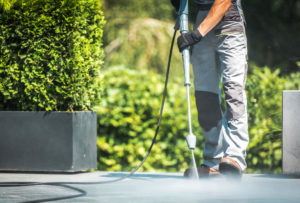Spring Cleaning: Preparing for Warmer Weather

Assessing Winter's Damage
Winter can take a toll on buildings and grounds. Before the warm weather arrives, it’s important to assess the damages and make the necessary repairs to ensure safe grounds for the warm months ahead.
Parking Lots
Salt, ice, and snowplows have been known to inflict major damage on asphalt parking lots. To minimize potential injuries, please follow these guidelines:
- Look out for any holes or large cracks that can cause trips, falls, and water accumulation. Temporarily fill the holes with sand or hire a contractor to fill in the holes and cracks.
- Repaint speed bumps, curbs and other raised surfaces with yellow safety paint to make them as visible as possible.
- Poorly marked or hard-to-see barriers can actually increase the likelihood of an accident. Typical methods of cordoning off parking lots, like draping chains or cables across lot entrances, can be hard to see, especially in low light or poor weather. These obstacles pose a threat to cyclists, skateboarders, motor vehicles and pedestrians.
- If you are using chains and cables, use high visibility, flexible plastic tubing to cover the length of the chain or cable. In addition, consider attaching hanging signs to barriers to increase visibility and warn trespassers that they do so at their own risk.
Stairs and Railings
Inspect exterior steps to ensure there is no cracking or chipping on the edge where the riser meets the tread. Check handrails to make sure they are not loose or damaged.
Chimneys
As with other heating systems, chimneys need to be cared for on a regularly-scheduled basis. If a chimney is not properly cleaned and maintained, the result may be fire or carbon monoxide poisoning. Stress from snow and ice could produce cracks in the flue or mortar joints, in turn allowing the flames and heated gases to extend into the structure. Have your chimney inspected for damage —both inside and out —by a qualified professional.
Roofs
We all know April showers bring May flowers. And if your roof has been damaged by winter’s snow and ice, the showers may also bring property damage in the form of leaky roofs. Be sure to inspect your roof for any damage done over the winter and make the repairs as soon as possible. In particular, check the flashing on the roof. Flashing is material used over joints in the roof to prevent water seeping in and causing damage. Look for other signs that your roof may be in need of repair:
- Cracked or split wood members
- Noticeable sagging of any kind
- Bends or ripples in supports
- Cracks in walls or masonry
- Sheared off screws from steel frames
- Sprinkler heads that have dropped down below ceiling tiles
- Doors that pop open
- Doors or windows that are difficult to open
- Bowed utility pipes or conduit attached at ceiling
- Creaking, cracking or popping sounds
Walkways and Lawns
- Remove and dispose of dead branches, trees or shrubs that may cause trips and falls.
- Inspect sidewalks and lawns for damage or holes that may present a tripping hazard.
- If pesticides are used for lawncare, post warning signs on lawns for at least 72 hours after pesticide use.
- Remove poisonous plants, such as poison ivy, oak and sumac. These plants should not be burned.
Tree Maintenance
Trees can be severely damaged by snow and ice. Given our unusually harsh winter, now is the time to inspect your trees and assess the damage. But be cautious: decisions made soon after the damage occurs can, and will, determine whether or not a damaged tree survives.
Have your grounds personnel or a professional tree-care service inspect trees for obvious safety issues, such as hanging or loosely attached branches and split trunks. To avoid the possibility of personal injury and/or property damage, these issues should be addressed immediately. Remove hazardous branches first. If a branch is broken but firmly attached and not in danger of falling, prune these branches. Remember: never remove limbs that have electrical wires running through them; call your electricity provider instead.
If a trunk is split down the middle, it may need to either be braced or removed. Consult with a professional tree-care service or arborist.
For more information on tree pruning and maintenance, and to access an online directory of certified aborists in your area, please go the International Society of Aboriculture (ISA)’s website.
Playgrounds
Do a visual inspection of your playground area to make sure the equipment and grounds are safe.
- Inspect the playground area and remove large rocks and debris that could cause children to trip.
- Inspect equipment for sharp edges and dangerous hardware, such as protruding bolts or open “S” hooks.
- Check that surfaces around and under play equipment have a minimum of 12” of wood chips, mulch, sand or pea gravel.
- Ensure that equipment is anchored firmly in the ground.
- Maintain spacing between equipment –at least nine feet should be adequate.
- If the playground has a fence or other enclosure, make sure it is in good repair.
Roofs and Drain Pipes
- Check for loose or missing gutters or flashing.
- Repair damage to lightning rods.
- Clear leaves and debris from exterior drains.
- Inspect roofs for damage from ice and snow accumulation and replace missing slates or shingles.
- Service sump pumps.
Equipment & Utility Systems
- Service lawn and landscaping equipment.
- Check air conditioning units and replace filters, if needed.
- Shut down boilers properly for the season.
- Change the furnace filter and check the blower.
- Check all plumbing and electrical systems and repair any damage.
Windows
- Remove, clean and store storm windows (if applicable).
- Inspect, clean and install screens for windows and doors.
- Seal or re-caulk windows.

